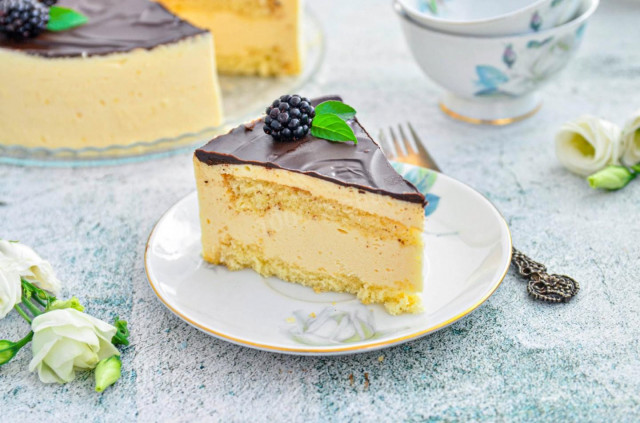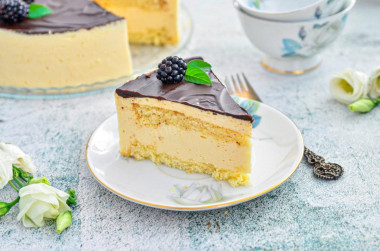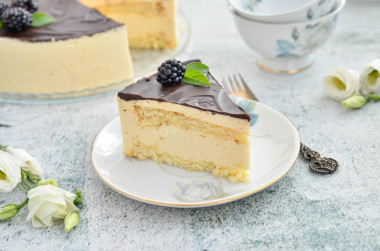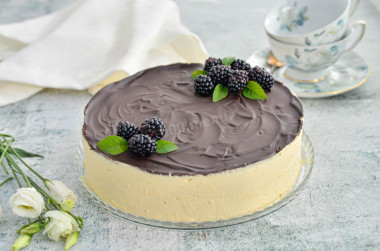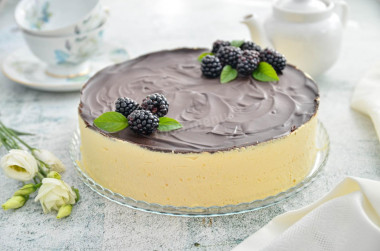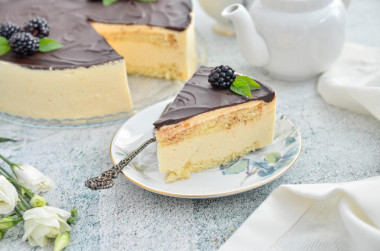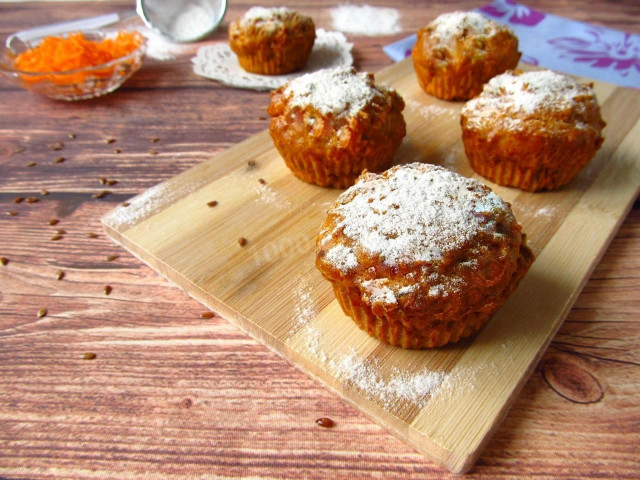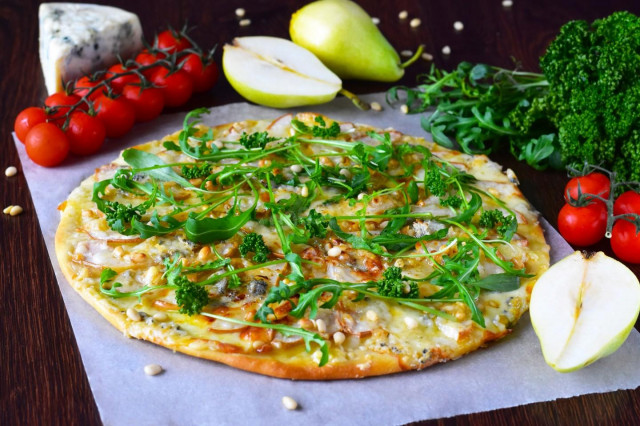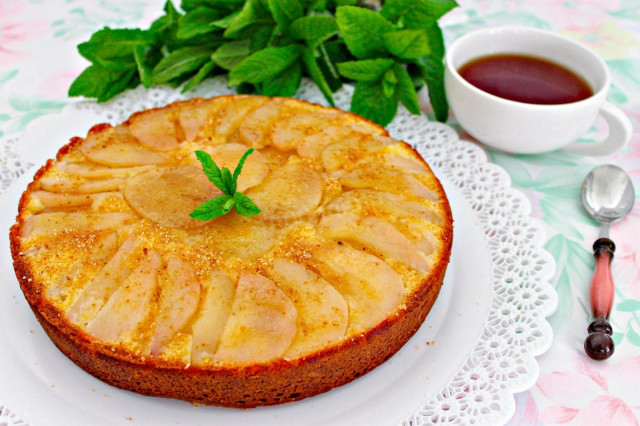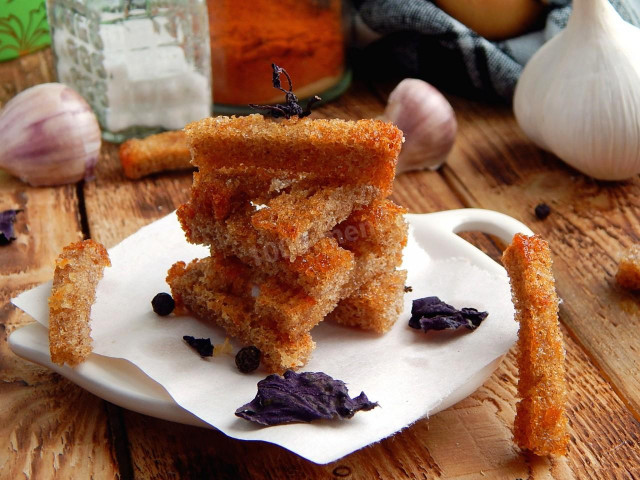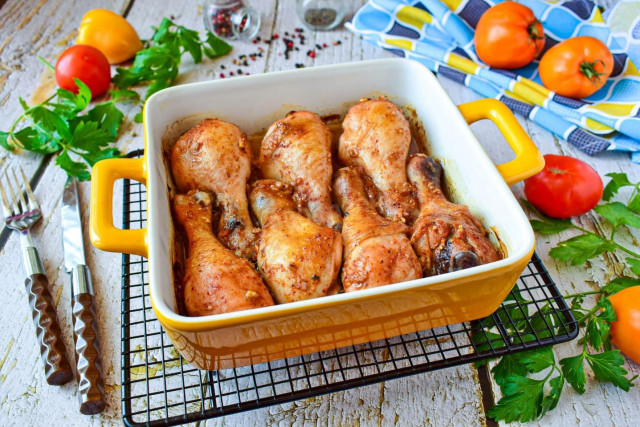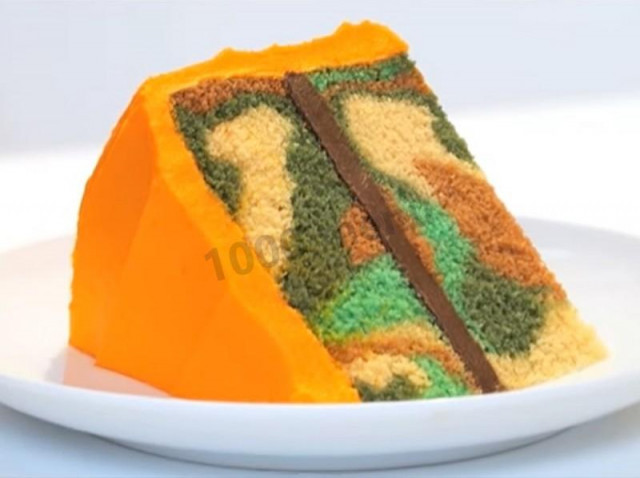Composition / ingredients
Step-by-step preparation
Step 1:
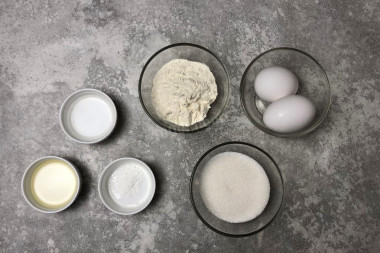
How to bake a bird's milk cake on gelatin? First make a sponge cake. Prepare the products for him.
Step 2:
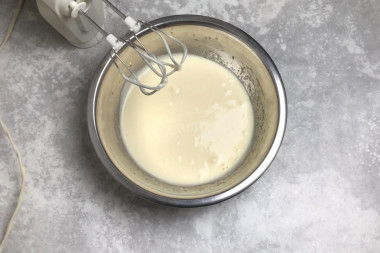
Beat eggs with sugar until fluffy light mass. Beat at medium speed of the mixer. Then air bubbles of the same size are formed in the mass, and it will not fall off when baking. If you whip at high speed, large bubbles will burst quickly and the biscuit will fall off.
Step 3:
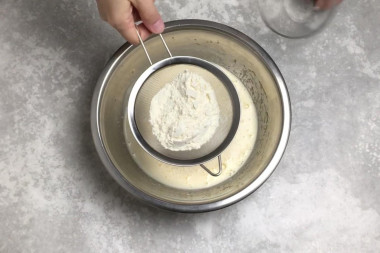
Pour the baking powder into the flour, mix. Sift the flour to the egg mass.
Step 4:
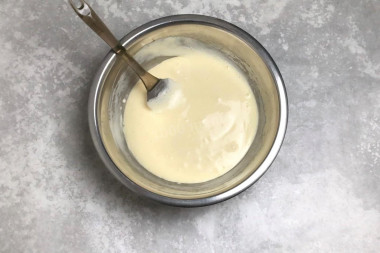
Gently mix the flour and eggs with a silicone spatula. In this way, you will save the maximum number of air bubbles formed during whipping in the dough, and the biscuit will eventually rise well. Add vegetable oil and boiling water to the dough. Mix it up.
Step 5:
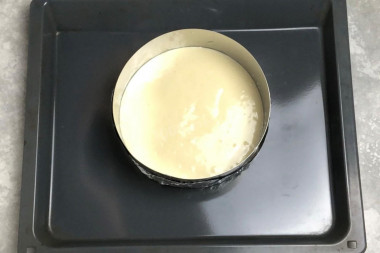
Prepare a biscuit baking dish. You can use any one you have. If it is large, the cake will turn out to be low, if it is small, it will turn out to be high. I have a baking ring with a diameter of 20 cm. I made the bottom out of foil. Lubricate the bottom of the mold with a small amount of vegetable oil. Do not lubricate the walls - then the biscuit will not fall off during baking.
Step 6:
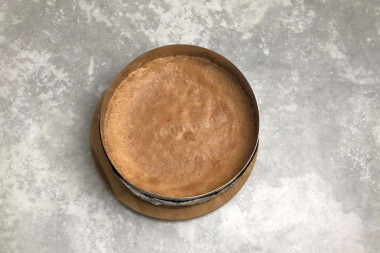
Bake the sponge cake in the oven, preheated to 170 ° C, for 25-30 minutes. He should blush. determine readiness with a toothpick. If you stick it in and take it out of the center of the biscuit and it comes out dry, it's ready. Cool the biscuit and only then remove it from the mold.
Step 7:
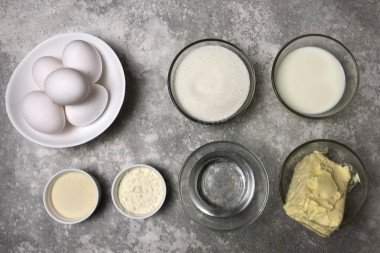
Next, prepare a cream souffle. Prepare the products for him. Remove the oil from the refrigerator in advance - it should become absolutely soft.
Step 8:
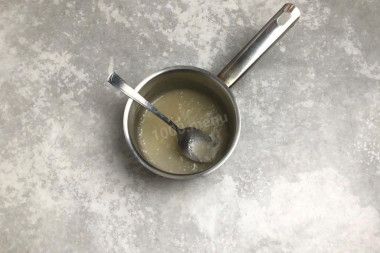
First of all, soak the gelatin in cold, clean water. It should stand for about 20 minutes and swell.
Step 9:
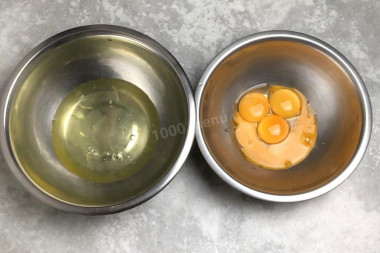
Divide the eggs into yolks and whites. do it carefully, one egg at a time. Even a piece of yolk should not get into the whites - they will not climb.
Step 10:
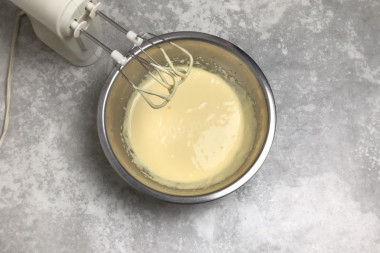
Add 100 grams of sugar to the yolks. Whisk them to a fluffy light mass.
Step 11:
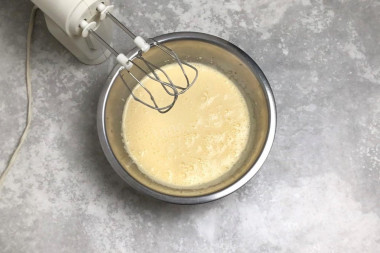
Add milk and flour to them, whisk again.
Step 12:
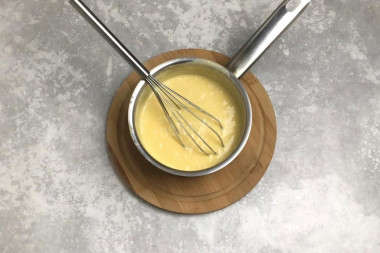
Pour the mass into a saucepan with a thick bottom. Put it on a small fire. With constant stirring with a whisk, bring the mixture to a thickening. Be careful not to overcook the mass, the eggs can turn into an omelet. As soon as the mass begins to thicken, immediately remove it from the fire. If you are not confident in your abilities - cook everything in a water bath. But I think that you will succeed without it, do not forget to stir the eggs all the time. Cool the resulting base.
Step 13:
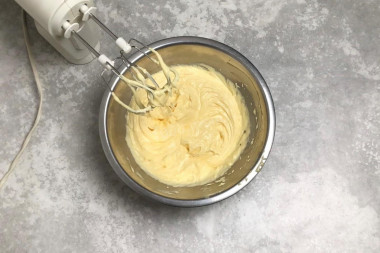
Beat the softened butter until fluffy and, without ceasing to beat, start adding the custard base to it. Add it one tablespoon at a time, whisking after each. Then the cream will turn out gentle and homogeneous. So add the whole base.
Step 14:
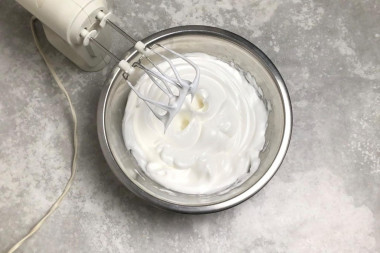
Add the remaining sugar to the proteins - 100 grams - and beat them to strong peaks. It is necessary to beat for a long time so that the mixer leaves a clear trace on the proteins. After whipping, this trace in the form of peaks should not fall off.
Step 15:
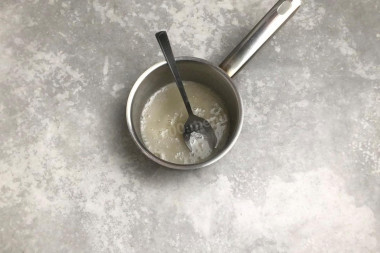
Gelatin meanwhile absorbed all the water. Put the ladle with it on a small fire. Stirring, bring the gelatin to a liquid state, but in no case boil it. When boiling, it will lose its gelling properties.
Step 16:
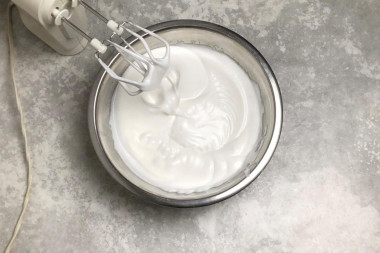
Cool the gelatin a little and pour it into the whipped whites. Beat them again, achieving strong peaks.
Step 17:
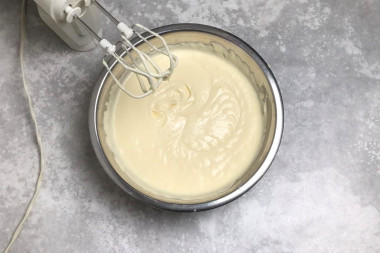
Continue to beat the whites, adding to them a cream of yolks and butter. And again add it in portions, stirring well after each. You should get a fairly liquid homogeneous mass.
Step 18:
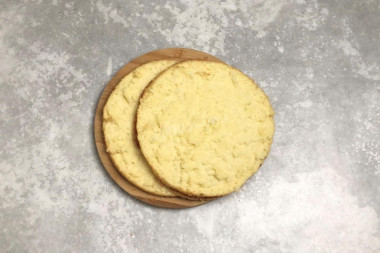
Cut the biscuit into two parts. If you baked it in a wide form, then leave it in one layer.
Step 19:
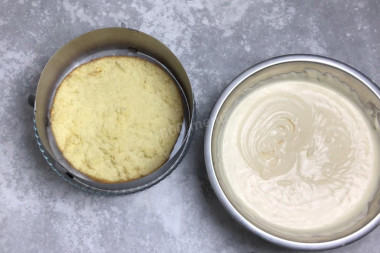
It is better to assemble this cake in a split form. Put a biscuit on the bottom - whole or half. It is better if it is slightly smaller than the diameter of the mold - then the cake will be beautiful on the side - completely made of souffle.
Step 20:
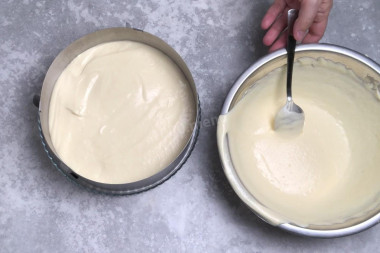
Pour the cream on top of the sponge cake. Quite a bit - the fifth part - leave for the top layer. If your cake is not high, pour out all the cream at once.
Step 21:
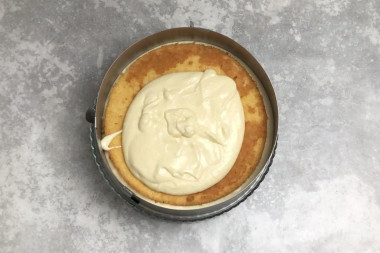
Put the second half of the biscuit on the cream. Pour the remaining cream on top.
Step 22:
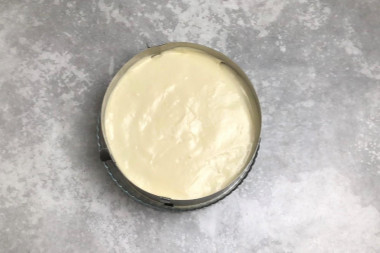
Flatten it with a spoon and send it to the refrigerator until completely solidified.
Step 23:
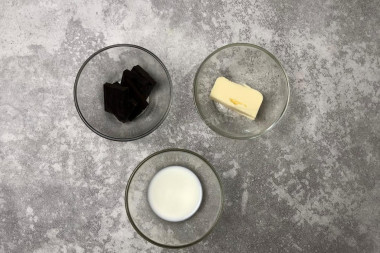
Prepare the glaze. Prepare the products for her. Take dark chocolate - it will taste better due to tartness.
Step 24:
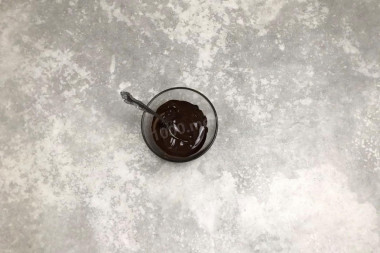
Melt the chocolate in any way. I heated it in the microwave. It should become liquid.
Step 25:
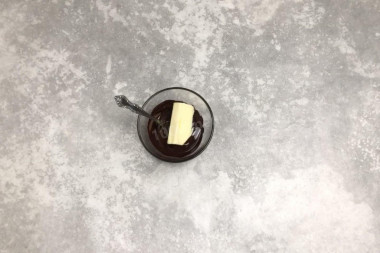
Add butter to it, mix.
Step 26:
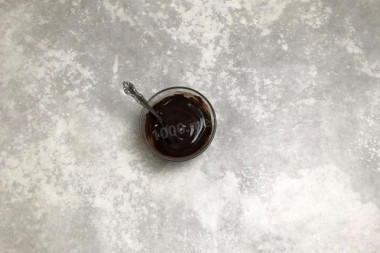
Pour in the hot milk. Stir. The glaze is ready. It should become smooth and homogeneous.
Step 27:
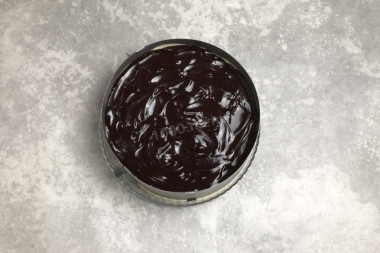
Pour the icing on the frozen cake, flatten it with a spoon. It will not lie absolutely flat, but this has its own charm - it turns out a beautiful pattern on top. Put the cake in the refrigerator until the glaze solidifies. Release the finished cake from the mold by holding a sharp knife between the wall and the side of the cake.
I tried baking Bird's milk according to five different recipes, and I say with confidence that the cake according to this recipe turned out to be the most delicious. The souffle is perfectly frozen, sugar in moderation, the sponge cake is soft. I really liked the glaze - like on a popsicle in Soviet times. Now it's our family's favorite cake.
Why gelatin hardens badly, how to avoid unpleasant gelatin lumps in the dish, as well as all the secrets and subtleties of cooking read in the article about gelatin .
Keep in mind that everyone's ovens are different. The temperature and cooking time may differ from those specified in the recipe. To make any baked dish successful, use useful information about the features of ovens !
So that the oven has time to heat up to the desired temperature, turn it on in advance (10-20 minutes before the start of cooking).
Calorie content of the products possible in the dish
- Whole cow's milk - 68 kcal/100g
- Milk 3.5% fat content - 64 kcal/100g
- Milk 3.2% fat content - 60 kcal/100g
- Milk 1.5% fat content - 47 kcal/100g
- Concentrated milk 7.5% fat content - 140 kcal/100g
- Milk 2.5% fat content - 54 kcal/100g
- Chicken egg - 157 kcal/100g
- Egg white - 45 kcal/100g
- Egg powder - 542 kcal/100g
- Egg yolk - 352 kcal/100g
- Ostrich egg - 118 kcal/100g
- Milk-nut chocolate - 542 kcal/100g
- Nutty chocolate - 580 kcal/100g
- Porous milk chocolate - 506 kcal/100g
- Cream chocolate - 560 kcal/100g
- Chocolate - 550 kcal/100g
- Whole durum wheat flour fortified - 333 kcal/100g
- Whole durum wheat flour, universal - 364 kcal/100g
- Flour krupchatka - 348 kcal/100g
- Flour - 325 kcal/100g
- Granulated sugar - 398 kcal/100g
- Sugar - 398 kcal/100g
- Butter 82% - 734 kcal/100g
- Amateur unsalted butter - 709 kcal/100g
- Unsalted peasant butter - 661 kcal/100g
- Peasant salted butter - 652 kcal/100g
- Melted butter - 869 kcal/100g
- Vegetable oil - 873 kcal/100g
- Gelatin - 355 kcal/100g
- Water - 0 kcal/100g
- Baking powder - 79 kcal/100g

